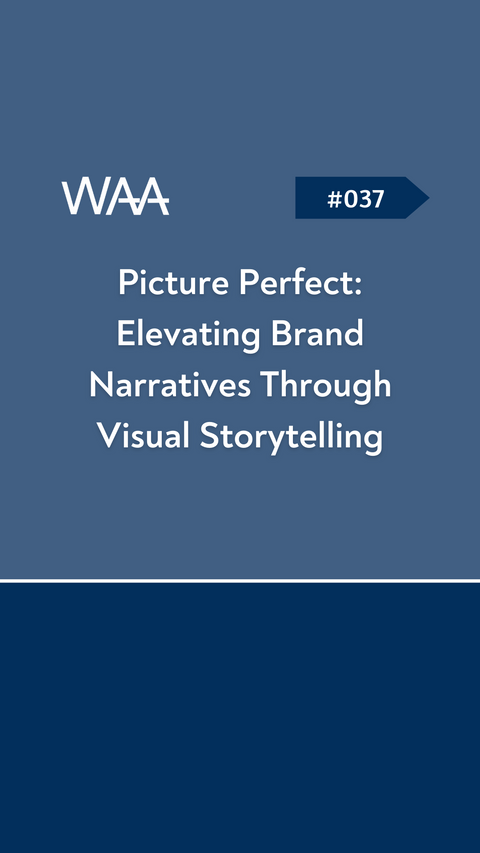
#037 Picture Perfect: Elevating Brand Narratives Through Visual Storytelling
Visual Storytelling: Using Images to Enhance Narratives
In the fast-paced digital world, capturing the attention of your audience and conveying your brand's message effectively is no small feat. One powerful tool that brands can utilize in their storytelling efforts is visual storytelling. By incorporating compelling images into your narrative, you can engage your audience on a deeper level, evoke emotions, and create a lasting impact. In this blog post, we will explore the concept of visual storytelling, its role in brand storytelling, and how it can be leveraged for effective marketing.
Understanding Visual Storytelling
Visual storytelling is the art of conveying a narrative or message through images or visuals. It harnesses the power of visuals to evoke emotions, convey information, and captivate the audience's attention. By using compelling images, illustrations, infographics, videos, or animations, brands can enhance their storytelling efforts, making their message more engaging, memorable, and impactful.
The Role of Visual Storytelling in Brand Storytelling
Brand storytelling is the strategic use of narratives to evoke emotions, build brand identity, and create a connection with the audience. Visual storytelling complements brand narratives by adding depth, visual appeal, and emotional resonance. Here are some key roles that visual storytelling plays in brand storytelling:
-
Creating Emotional Connections: Visuals have the power to evoke emotions and connect with the audience on a deeper level. By incorporating relevant and emotionally compelling visuals into brand narratives, brands can create a more memorable and impactful experience for their audience.
-
Enhancing Brand Identity: Visuals can help convey and reinforce a brand's identity and values. By using consistent visual elements such as colors, typography, and imagery, brands can reinforce their identity and make it visually recognizable to their audience.
-
Simplifying Complex Information: Visuals can simplify complex information or concepts and make them easier to understand and digest. Infographics, charts, or diagrams can transform data or complex ideas into visually appealing and easily understandable formats, enhancing the effectiveness of brand communication.
-
Capturing Attention: In today's information-saturated world, grabbing and maintaining the attention of the audience is crucial. Visuals have a higher likelihood of catching the eye and engaging the audience. Brands can leverage visually striking images or videos to capture attention and draw the audience into their brand narrative.
-
Increasing Memorability: Studies have shown that people are more likely to remember visual information than textual information. By incorporating visual elements into their brand storytelling, brands can increase the chances of their message being remembered and recalled by the audience.
Using Visual Storytelling for Effective Marketing
Visual storytelling can be a powerful tool in a brand's marketing efforts. Here are some strategies to leverage visual storytelling for effective marketing:
1. Choose Relevant and Authentic Visuals: Select visuals that are relevant to your brand and resonate with your target audience. Authentic and relatable visuals have a greater impact and build trust with the audience.
2. Tell a Cohesive Story: Create a consistent visual narrative across all marketing channels and touchpoints. Ensure that the visual elements align with your brand's messaging, values, and identity, reinforcing the overall brand story.
3. Use High-Quality Visuals: Invest in high-quality visuals that reflect the professionalism and quality of your brand. Whether it's professional photography, illustrations, or videos, visually stunning content will leave a lasting impression on your audience.
4. Leverage Social Media: Social media platforms are visual-centric, making them ideal for visual storytelling. Utilize platforms like Instagram, Pinterest, or YouTube to share visually appealing and engaging content that tells your brand's story and captivates your audience.
5. Encourage User-Generated Content: Encourage your audience to create and share their visual stories relating to your brand. User-generated content adds authenticity and can create a sense of community around your brand.
Conclusion
Visual storytelling is a powerful tool that enables brands to enhance their narratives, evoke emotions, and create a lasting impact on their audience. By complementing brand narratives with compelling visuals, brands can create emotional connections, enhance their identity, simplify complex information, capture attention, and increase memorability. Leveraging visual storytelling in marketing efforts can result in more engaging and effective communication with the target audience. Remember, a picture is worth a thousand words, and when used strategically, visual storytelling can take your brand's storytelling and marketing efforts to new heights.
